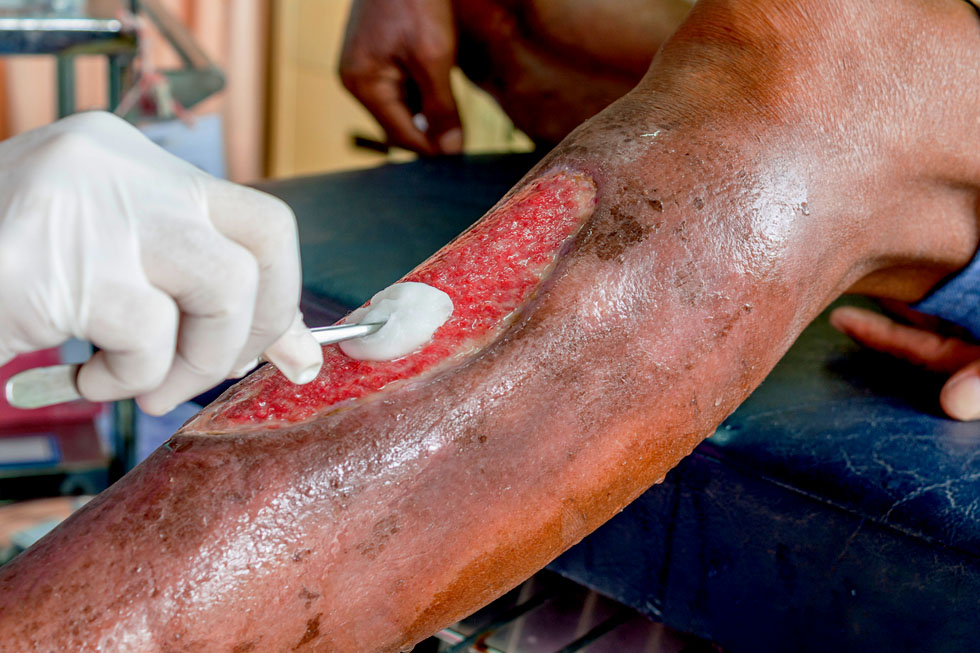Chronic, non-healing wounds caused by diabetic foot ulcers, venous ulcers, post-surgical wounds and abscesses are a major issue affecting millions of people worldwide. These kinds of wounds often lead to significant morbidity, impacting the quality of life of those affected. Hyperbaric oxygen therapy (HBOT) is a promising adjuvant treatment for these types of wounds that has been shown to improve the healing process, reduce infections, and provide additional benefits such as reducing inflammation and stimulating tissue regeneration. In this blog article we will discuss in depth the benefits of using HBOT for chronic non-healing wounds caused by diabetes, venous insufficiency, surgery and infection.
The primary effect of hyperbaric oxygen therapy is its ability to increase the partial pressure of oxygen in the blood stream and tissues. This increase in oxygenation helps cover the energy demands required for wound healing and reduces the incidence of wound infections due to anaerobic bacteria which are unable to survive in a highly oxygenated environment. The increased levels of oxygen also increases the production of reactive species with hormetic activity which stimulates signalling pathways involved in regulating inflammation mediators such as cytokines, infection fighting agents like white blood cells and growth factors necessary for tissue repair.
In addition to increasing tissue oxygenation and stimulating signalling pathways, HBOT can also reduce inflammation by suppressing proinflammatory cytokines associated with chronic inflammatory diseases. This suppression can help reduce pain levels associated with chronic wounds as well as limit damage from oxidative stress due to free radicals present during wound healing processes. Moreover, it has been shown that HBOT can stimulate fibroblasts (cells responsible for collagen production) which help form granulation tissue necessary for wound closure without scarring or contractures when combined with other treatments such as compression bandaging or debridement.

HBOT is particularly beneficial in treating diabetic foot ulcers due to its ability to improve circulation in areas affected by peripheral neuropathy which makes them prone to ulcerations. Clinical studies have found that HBOT was effective at improving circulation and significantly reducing both healing time and amputation rates while also decreasing hospitalization times associated with long term treatment plans. It has also been shown that HBOT may be able to target pathogenic bacteria within deep tissues leading to effective wound sterilization without resorting to surgical techniques or antibiotics.
The use of HBOT can be extremely beneficial for venous leg ulcers as well since it increases circulation within vessels near the site of injury resulting in increased delivery of nutrients needed for repair while simultaneously reducing edema (swelling). Furthermore, because these ulcers often develop due to insufficient lymphatic drainage from surrounding areas using HBOT may be more effective than conventional treatments such as compression bandaging alone since it does not require regular adjustments or replacements which can be difficult for individuals suffering from impaired mobility or reduced sensation in their legs/feet who often experience these types of wounds .
HBOT has also been used effectively on post surgical wounds where it’s shown promise at accelerating healing while minimizing scarring due primarily to its effectiveness at increasing circulation near the area being treated while promoting anti-inflammatory actions. Finally HBOT has been shown useful in treating abscesses where it helps promote antiseptic action through sterile debridement while simultaneously preventing necrosis (tissue death) thanks to its powerful anti-inflammatory properties .
Hyperbaric oxygen therapy provides a safe alternative method for treating chronic non-healing wounds caused by diabetic foot ulcers, venous ulcers, post surgical wounds and abscesses without exposing patients directly to antibiotics or invasive procedures . Its ability to provide an increase in partial pressure of oxygen results in improved circulation for wound healing while reducing the incidence of infections associated with anaerobic bacteria, thus helping with regeneration of tissues and promoting faster healing along with less scar formation due to its powerful anti-inflammatory actions and stimulation of effects fibroblast cells responsible for collagen production. When used alongside other treatment options such as compression bandaging or cauterization it can prove even more effective by providing adjuvant benefits such as suppression of inflammation and increased delivery of nutrients needed for the wound healing without any residual damage or visible signs of previous injury making it a highly recommended approach when dealing with complex cases

